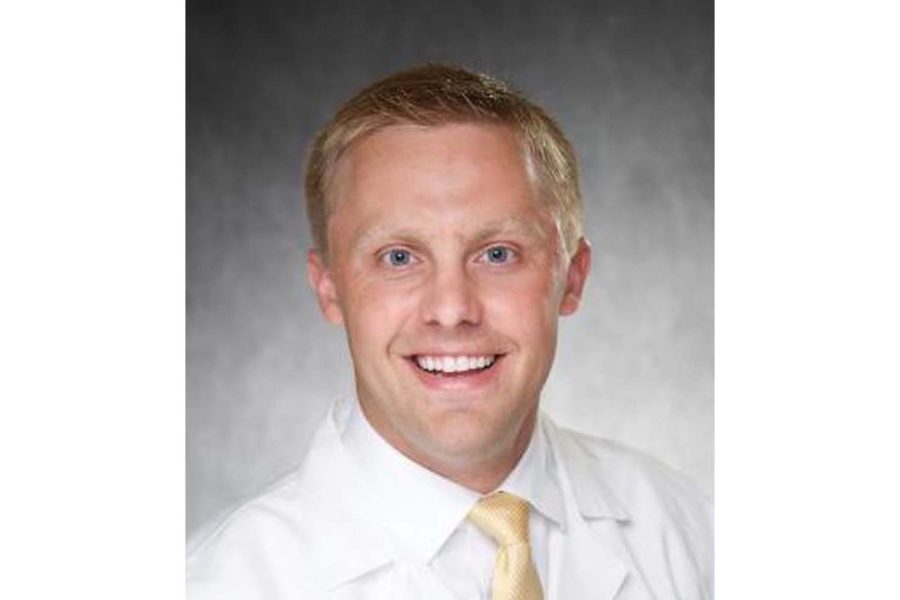UIHC to offer food resources to pregnant patients facing food insecurity
A UI research team will partner with a local food bank to provide food for high-risk pregnant women facing food insecurity. The team will screen patients to identify which patients to assist.
Contributed of Michael L Haugsdal.
March 31, 2022
An interdisciplinary research group at the University of Iowa is collaborating with a local non-profit food bank to identify and serve pregnant patients at UI Hospitals and Clinics who are facing food insecurity.
Michael Haugsdal, a UI clinical assistant professor of obstetrics and gynecology and leader on the project, said his team, the Upstream Initiative, received up to $100,000 from the UI Carver College of Medicine in late February this year.
The team will conduct screenings on obstetrical patients to identify who is burdened with food insecurity and why, he said.
Angie Albright, Hawkeye Area Community Action Program food reservoir assistant director, said the nonprofit received a grant in May 2021 to start their partnership with health care providers.
The funding will enable the non-profit to provide a food resources to the UI team for free.
“It’s a pilot program where we screen our obstetrical patients for potential food insecurity,” Haugsdal said. “And when we identify patients who might be food insecure, our goal is to be able to offer them at that moment some food resources.”
Haugsdal said his team already screens patients for food insecurity but does not yet provide food.
Kim Guardado, Hawkeye Area Community Action program’s food reservoir director, said the nonprofit has over 170 partners in total, working to get food out to those who need it.
“The health care partner project is one of the projects that we’re working on to reach greater populations in our area,” she said.
When the medical partnership launches, high-risk pregnant patients in need will receive food resources that meet their specific health requirements, Haugsdal said.
“Access to food but access to appropriate food is very important for these patients,” he said.
Patients with chronic diet-related diseases like diabetes are among those most affected by food insecurity, he said.
“For a diabetic, whether you’re pregnant or not, food really acts as a source of medicine,” he said.
Haugsdal’s team will provide food to high-risk pregnant patients with more protein than carbs, which especially affects patients with two or more diseases, like gestational diabetes or hypertension, he said.
He added that the food will be safe, shelf-stable, nutritious, and immediately available for patients in the clinic.
“We want to start with shelf-stable food items, just because that’s the easiest way,” Guardado said. “They [UIHC] have patients coming from long distances, so shelf-stable food is easier to take on a bus.”
Haugsdal said a goal of the project is to learn from his food-insecure patients about what their experience is like and why they lack proper food resources.
The rate of food insecurity among adult Iowans, Haugsdal said, fluctuates between 10-15 percent. Conversely, nearly 20-24 percent of his obstetrical patients in the high-risk UIHC obstetrics clinic will be food insecure at some point during their pregnancies.
The Black and Hispanic populations in Iowa are more likely to screen positive for food insecurity, he said, in addition to patients with chronic diseases.
Albright said the UI had been interested in the medical partnership since 2018, discussing the idea of an on-site hospital food pantry ever since.
“I think that would be a pipe-dream for all of us,” Albright said. “That would be wonderful. It’s really kind of the newest innovation in healthcare partnerships in foodbanks is having an on-site pantry in a hospital.”
Albright said this initiative is especially important because the federal Supplemental Nutrition Assistance Program benefits will scale back to pre-pandemic levels April 1.
“If you couple that with the price of the economy and groceries, utilities, rent, people that have food insecurity are going to be facing a larger crisis than they have for a very long time,” she said.
Albright said the Hawkeye Area Community Action Program’s collaboration with UIHC health care providers “makes perfect sense,” because of this approaching cutoff.
“That is a minimum impact of ninety dollars per person,” she said. “So, every person receiving SNAP benefits will receive a minimum of ninety dollars less a month for their groceries.”
Editors note: The Daily Iowan used the term “food pantry” instead of the correct term “food resources”. The DI regrets this error.



